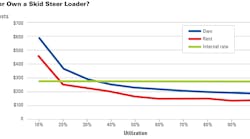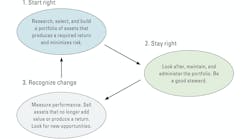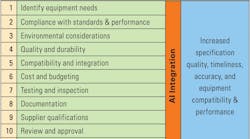It is difficult to strike a balance between a fleet that is large enough to support operations and a fleet that ties up capital in equipment assets that stand idle. The key to success lies in knowing where things are and in knowing how hard each unit is working. You need to measure and manage three key ratios: deployment, availability, and utilization.
Deployment
The first row in the diagram above shows that everything starts with the selection and acquisition decision: You own machines all day every day throughout their total ownership period. A machine cannot work if it is not deployed on site, therefore deployment—the time a machine is on site and expected to work as a percentage of the total ownership period—is an extremely important metric. It is frequently expressed in weeks per year and can vary a lot.
Weeks deployed times 40 hours per week is a critical number in the rate calculation as it determines the number of hours over which the organization recovers the fixed costs of ownership. Therefore, you must know how much time a machine spends on site, in the yard, and in various storage areas. You also need to know if the machine is deployable—up and ready to go—or not deployable.
The light blue block at the end of the second row—the time a machine is owned but not deployed—is, in the true sense of the word, a waste. Money is tied up in an asset, but the asset is not deployed to site and is not able to contribute to the success of the business.
It is unrealistic to expect that every machine is deployed at all times, and you cannot expect to manage the size and composition of the fleet so that there is no deployment waste. The important thing is to measure deployment and ensure that the right people manage the risks that arise because of a corporate strategic decision to hold assets pending a change in the market. Day-to-day operating-level equipment management can do little to manage deployment waste. It can only measure it and constantly question the need to own assets that are not on job sites earning their keep.
Availability
Once a machine is deployed on site and expected to work, it must be able to work. This is where availability—the time the machine is on site and able to work as a percentage of the time a machine is on site—comes into play.
The diagram shows two kinds of waste at the end of the third row. The first, which is clearly waste, is the time the machine is on shift and expected to work but is not able to work due to a breakdown or other mechanical reason. The second, which is not quite as clear, is the time the machine is down and not able to work but is off shift and not required to work.
On-shift downtime is damaging to a company’s ability to produce completed construction and must be reduced to a minimum. This is clearly an operating-level equipment-management issue that can be dramatically reduced by effective preventive maintenance, inspection, and condition-assessment programs. You simply cannot afford high levels of on-shift downtime. Availability and reliability are key metrics in measuring the effectiveness of everything a company does to improve reliability and uptime. It is essential that they are measured.
Collecting the data needed to measure on-shift downtime is difficult. Most companies rely on subjective opinion rather than hard data. Communicating with statements such as “This machine breaks down a lot” is no substitute for knowing the facts and being able to say, “This machine is available and able to work for 93 percent of the time it is on site.” Although downtime is difficult to record on a routine basis, any competent work-order system should be able to record the number of on-shift hours that elapse between the time a machine is tagged out for repair and the time it is returned to service. It should be possible to use this information to determine the time the machine is on-shift but not able to work.
Utilization
The last of the three key ratios is utilization. The fourth row in the diagram shows that utilization is time the machine is actually working on site expressed as a percentage of the time the machine is on site and able to work. The row also defines the waste associated with utilization as the time a machine is on site and able to work but is not working. Utilization waste is also an emotionally charged subject. How do you measure hours worked? How do you allow for the standby time inherent in the planning and sequencing of all construction operations?
Two things are clear. First, utilization waste is difficult to reduce to zero, and second, utilization waste is not an operating-level equipment-management issue. Equipment managers can do very little to improve utilization on site. The risks associated with utilization waste must be carried at job level, where job management can take action to reduce it as far as working conditions and job constraints will permit.
Summary
The diagram shows two things. First, deployment, utilization, and availability stack on top of each other and the waste can quickly become large. Suppose you expect your front-line high-production excavator to be deployed to site for 50 weeks per year at 40 hours per week. Suppose you achieve an actual deployment of 45 weeks (or 90 percent). This deployment is very good because it only leaves you 5 weeks per year for time in the yard, time in transit, and for other times when the machine is not actively engaged on site. A 90-percent deployment gives you a maximum of 1,800 hours per year deployed to site and expected to work.
Now assume an availability of 90 percent, which is also pretty good. This gives you 1,620 hours when the machine is on site and able to work. If the site runs well and there are limited delays, then you may achieve a utilization of 90 percent.
That gives you 1,458 working hours or 72 percent of the 2,000 hours per year we started with. We would be delighted with a machine that achieves 90 percent for deployment, availability, and utilization. I do not know that we would be all that happy with an end result of 1,458 hours per year.
Second, the diagram shows that three distinct parties are responsible for and carry the risks associated with three different forms of waste. Deployment waste is a company-level risk involving strategic planning, selection, acquisition, and fleet replacement. Downtime risk is clearly an operating-level equipment-management issue that depends on effective preventive maintenance, inspection, and condition-assessment programs. Utilization risk is a job-site issue almost entirely dependent on the flow, sequence, and tempo of the work.
Success depends on how you integrate and use the operational data you collect in many parts of the business. The data for location and time on site that is needed for the deployment calculation is in your dispatch system, your job-costing system, and your work-order system. It needs to be trued up and used; you cannot be blind or uncertain when it comes to whether or not your assets are on site and contributing to your business. The data needed for the downtime calculation should be in the work-order system and in the job-costing system. It also needs to be trued up and used; you have to know if your machines are able to work when expected. Utilization data is in your job-costing system and in your fuel-management system. You will need to reconcile these to know how many hours your machines work.
Not knowing or being uncertain about deployment, availability, and utilization impacts fleet planning, equipment costing, job costing, and in the final analysis, estimating. You cannot afford to not know.
For more asset management, visit ConstructionEquipment.com/Institute.






